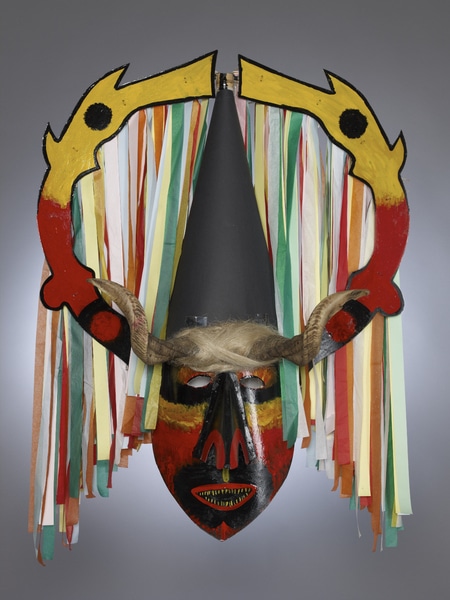Masquerade Costume Mask Item Number: 2956/200 a from the MOA: University of British Columbia

Description
Large mask made of cardboard with a protruding nose and horns on the forehead. Large headdress consisting of a tall black cone-shaped cardboard hat and semicircular cutout pieces on each side, surrounded by multi-coloured streamers. The mask is part of a costume that also includes a white shirt (2956/200 b), a red skirt (2956/200 c), a white apron (2956/200 d), a red sash (2956/200 e), a mask (2956/200 a), and two bells (2956/200 f-g).
History Of Use
Masks and masquerades in Mira (central Portugal) underwent waves of repression and reinvention during the 20th century. Mask making, which dates back at least to the 19th century, began to be restored at the beginning of the 21st century by Alirio Laranjeiro, the town cobbler. The Lagoa Football Club, with João Pinho, invigorated Carnival celebrations by organizing masquerades and encouraging families and supporters to make new masks and costumes, which are now performed at Carnival and civic events.
Item History
- Made by Caretos da Lagoa (Maker) in Mira, Coimbra, Portugal during 2011
- Collected by Anthony A. Shelton in Portugal between 2011 and 2012
- Owned by Anthony A. Shelton before September 17, 2012
- Received from Museum of Anthropology Exhibitions Budget (Funding source) and Anthony A. Shelton (Seller) on September 17, 2012
What
Who
- Culture
- Portuguese
- Creator
- Caretos da Lagoa (Maker)
- Field Collector
- Anthony A. Shelton
- Previous Owner
- Anthony A. Shelton
- Received from
- Museum of Anthropology Exhibitions Budget (Funding source) and Anthony A. Shelton (Seller)
Where
- Holding Institution
- MOA: University of British Columbia
- Made in
- Mira, Coimbra, Portugal
- Collected in
- Portugal
When
- Creation Date
- during 2011
- Collection Date
- between 2011 and 2012
- Ownership Date
- before September 17, 2012
- Acquisition Date
- on September 17, 2012
Other
- Condition
- good
- Accession Number
- 2956/0200 a